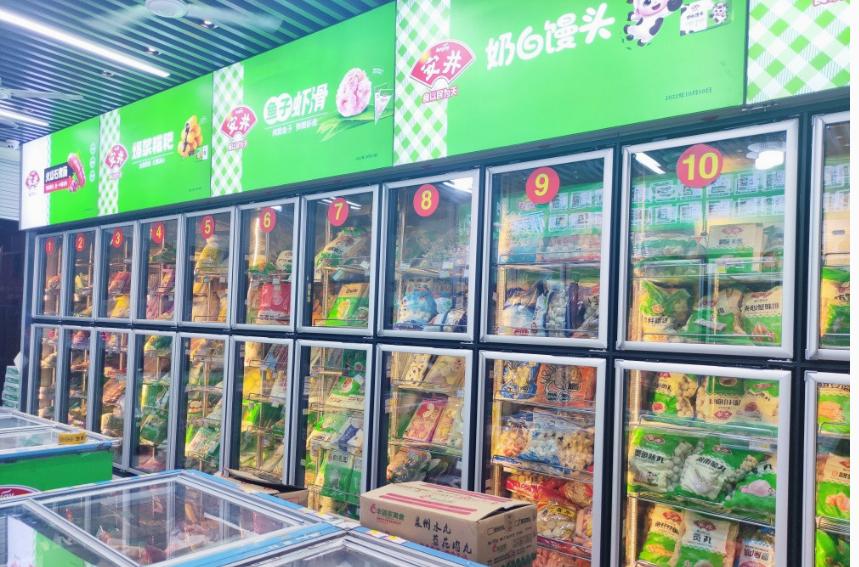
Modern supermarkets offer unparalleled convenience, but their high operating costs, particularly for energy, are a major industry pain point. A typical large hypermarket can spend anywhere from 1 to 3 million RMB annually on energy, with refrigeration units like display cabinets and freezers being the biggest culprits. These "energy hogs" often account for a staggering 50%-70% of a store's total power consumption. So, how can we tame this beast? The latest generation of energy-saving glass, vacuum insulated glazing (VIG), is proving to be a powerful tool for supermarkets looking to cut costs and boost efficiency.
The Superior Performance of Vacuum Insulated Glazing: A Double Breakthrough in Insulation and Anti-Condensation
The core advantage of vacuum insulated glass lies in its unique structure: two panes of glass separated by a vacuum cavity. This vacuum chamber effectively eliminates heat transfer through convection and conduction, giving the glass an exceptionally low heat transfer coefficient, or U-value. For example, an 8mm vacuum glazing produced by LandVac boasts a U-value of less than 0.4 W/(m²·K), which is significantly better than traditional insulated glass (around 2.6 W/(m²·K)) and single-pane glass (around 5.5 W/(m²·K)). This represents a monumental leap in thermal insulation performance.
When used for refrigerated display doors, VIG’s superior insulation drastically reduces the loss of cold air. Even more impressively, its outer surface temperature remains well above the ambient dew point, eliminating the problem of condensation and fogging. Shoppers no longer have to peer through a hazy pane, ensuring a clear and appealing view of products and an overall enhanced shopping experience.
Tangible Savings: The Numbers Speak for Themselves
Let's look at the numbers to see the real-world savings Vacuum Insulated Glazing can deliver. Based on the following assumptions for a typical supermarket:
Total glass door area of refrigerated cabinets: 300 m²
Internal cabinet temperature: -5°C
Store ambient temperature: 25°C (a temperature difference of 30°C)
Operation: 24/7, 365 days a year
Using the energy consumption formula:
Energy Consumption=U−value×Temperature Difference×Time×Area
The results are striking:
Vacuum Insulated Glass (U=0.45): Annual electricity consumption ≈ 35,478 kWh
Insulated Glass (U=2.6): Annual electricity consumption ≈ 204,984 kWh
Single-Pane Glass (U=5.5): Annual electricity consumption ≈ 433,620 kWh
The data is clear: using VIG on refrigerated doors alone can save about 83% of the electricity consumed by traditional insulated glass and a staggering 92% compared to single-pane glass. Based on this model, a single store could save nearly 170,000 kWh per year. At a commercial electricity rate of 0.8 RMB per kWh, this translates to annual savings of over 130,000 RMB. When this technology is expanded to other parts of the cold chain, such as observation windows and cold room doors, the cumulative savings are even more substantial. Leading home appliance brands like Haier, Bosch, and Ronshen have already adopted LandVac Vacuum Insulated Glass for their high-end refrigerator and freezer lines, a testament to its performance and reliability.

LandVac Vacuum Glazing for Refrigerator doors
Beyond Energy: A Multifaceted Investment
The value of VIG goes far beyond energy savings:
Reduced Operating Costs: Significant cuts in electricity bills directly improve a supermarket's bottom line and offer protection against fluctuating energy prices.
Enhanced Product Display: By preventing condensation, VIG ensures products are always clearly visible, stimulating consumer interest and boosting sales.
Increased Equipment Reliability: Reduced condensation lessens wear and tear on door seals and minimises the risk of electrical issues, lowering maintenance costs.
Improved Shopping Environment: Clear and clean cabinet doors enhance the overall look and feel of the store, creating a more comfortable shopping experience.
Commitment to Sustainability: The significant reduction in carbon emissions aligns with global "double carbon" goals and elevates a company's social responsibility profile.
Conclusion
In an era of rising operating costs and a critical need for energy efficiency, vacuum insulated glass offers a powerful solution to the high energy consumption of supermarket refrigeration systems. From providing a clear view of products and saving a significant amount on electricity bills to enhancing the customer experience and fulfilling corporate social responsibility, VIG is a key technological innovation that drives cost reduction and boosts competitiveness. Adopting VIG isn't just about choosing a material; it's about choosing a sustainable future.